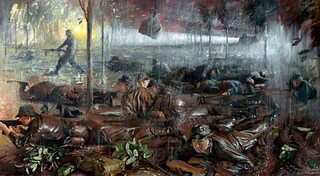
The Battle of Long Tan took place in a rubber plantation near Long Tân, in Phước Tuy Province, South Vietnam, during the Vietnam War. The action was fought between Viet Cong (VC) and People's Army of Vietnam (PAVN) units and elements of the 1st Australian Task Force.

The Battle of Ấp Bắc was a major battle fought on 2 January 1963 during the Vietnam War in Định Tường Province, South Vietnam. On 28 December 1962, US intelligence detected the presence of a radio transmitter along with a sizable force of Viet Cong (VC) soldiers, reported to number around 120, in the hamlet of Ap Tan Thoi in Dinh Tuong Province, home of the Army of the Republic of South Vietnam (ARVN) 7th Infantry Division. The South Vietnamese and their US advisers planned to attack Ap Tan Thoi from three directions to destroy the VC force by using two provincial Civil Guard battalions and elements of the 11th Infantry Regiment, ARVN 7th Infantry Division. The infantry units would be supported by artillery, M113 armored personnel carriers (APCs), and helicopters. However, Viet Cong forces anticipated a major attack from the South Vietnamese government from a variety of sources including movement of supplies, an undercover VC agent, and decoded radio communications from the ARVN. Accordingly, the VC prepared for an attack by US and South Vietnamese forces.
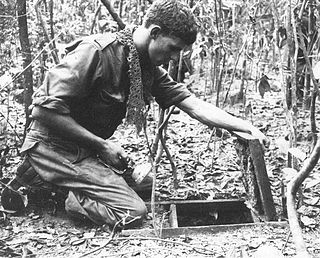
Operation Crimp, also known as the Battle of the Ho Bo Woods, was a joint US-Australian military operation during the Vietnam War, which took place 20 kilometres (12 mi) north of Cu Chi in Binh Duong Province, South Vietnam. The operation targeted a key Viet Cong headquarters that was believed to be concealed underground, and involved two brigades under the command of the US 1st Infantry Division, including the 1st Battalion, Royal Australian Regiment which was attached to the US 173rd Airborne Brigade. Heavy fighting resulted in significant casualties on both sides, but the combined American and Australian force was able to uncover an extensive tunnel network covering more than 200 kilometres, at the cost of 8 Australians and 14 Americans killed and 29 Australians and 76 Americans wounded.

The Battle of Coral–Balmoral was a series of actions fought during the Vietnam War between the 1st Australian Task Force and the North Vietnamese People's Army of Vietnam (PAVN) 7th Division and Viet Cong (VC) Main Force units, 40 kilometres (25 mi) north-east of Saigon. Following the defeat of the PAVN/VC Tet offensive in January and February, in late April two Australian infantry battalions—the 1st and 3rd Battalions of the Royal Australian Regiment (RAR)—with supporting arms, were again deployed from their base at Nui Dat in Phước Tuy Province to positions astride infiltration routes leading to Saigon to interdict renewed movement against the capital. Part of the wider allied Operation Toan Thang I, it was launched in response to intelligence reports of another impending PAVN/VC offensive, yet the Australians experienced little fighting during this period. Meanwhile, the PAVN/VC successfully penetrated the capital on 5 May, plunging Saigon into chaos during the May Offensive in an attempt to influence the upcoming Paris peace talks scheduled to begin on the 13th. During three days of intense fighting the attacks were repelled by US and South Vietnamese forces, and although another attack was launched by the PAVN/VC several days later, the offensive was again defeated with significant losses on both sides, causing extensive damage to Saigon and many civilian casualties. By 12 May the fighting was over, and the PAVN/VC were forced to withdraw having suffered heavy casualties. US casualties were also heavy and it proved to be their most costly week of the war.

Operation Hump was a search and destroy operation initiated by United States and Australian forces on 5 November 1965, during the Vietnam War.

The Battle of Gang Toi was fought during the Vietnam War between Australian troops and the Viet Cong. The battle was one of the first engagements between the two forces during the war and occurred when A Company, 1st Battalion, Royal Australian Regiment struck a Viet Cong bunker system defended by Company 238 in the Gang Toi Hills, in northern Biên Hòa Province. It occurred during a major joint US-Australian operation codenamed Operation Hump, involving the US 173rd Airborne Brigade, to which 1 RAR was attached. During the latter part of the operation an Australian rifle company clashed with an entrenched company-sized Viet Cong force in well-prepared defensive positions. Meanwhile, an American paratroop battalion was also heavily engaged in fighting on the other side of the Đồng Nai River.
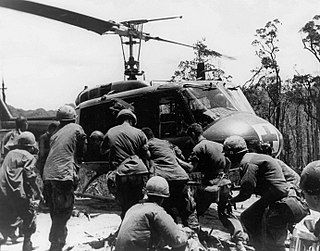
Operation Apache Snow was a joint U.S. Army and Army of the Republic of Vietnam (ARVN) military operation during the Vietnam War designed to keep pressure on the People's Army of Vietnam (PAVN) units in the A Sầu Valley and prevent them from mounting any attacks on the neighboring coastal provinces.

The Seventh Division was part of the Army of the Republic of Vietnam (ARVN), the army of the nation state of South Vietnam that existed from 1955 to 1975. It was part of the IV Corps, which oversaw the Mekong Delta region of the country.

Operation Coburg was an Australian and New Zealand military action during the Vietnam War. The operation saw heavy fighting between the 1st Australian Task Force and North Vietnamese People's Army of Vietnam (PAVN) and Viet Cong (VC) forces during the wider fighting around Long Binh and Bien Hoa.

The Battle of Hat Dich was a series of military actions fought between an allied contingent, including the 1st Australian Task Force and the People's Army of Vietnam (PAVN) and Viet Cong (VC) during the Vietnam War. Under the code name Operation Goodwood, two battalions from 1 ATF deployed away from their base in Phước Tuy Province, operating against suspected PAVN/VC bases in the Hat Dich area, in western Phước Tuy, south-eastern Biên Hòa and south-western Long Khánh provinces as part of a large allied sweep known as Operation Toan Thang II. The Australians and New Zealanders conducted sustained patrolling throughout the Hat Dich and extensively ambushed tracks and river systems in the Rung Sat Special Zone, occupying a series of fire support bases as operations expanded. Meanwhile, American, South Vietnamese and Thai forces also operated in direct support of the Australians as part of the division-sized action.

The Battle of Suoi Bong Trang was an engagement fought between US, Australian and New Zealand forces, and the Viet Cong and North Vietnamese Army during the Vietnam War. The battle occurred during Operation Rolling Stone, an American security operation to protect engineers building a tactically important road in the vicinity of Tan Binh, in central Binh Duong Province, 30 kilometres (19 mi) north-west of Bien Hoa airbase. During the fighting, soldiers from the US 1st Brigade, 1st Infantry Division and the 1st Battalion, Royal Australian Regiment, which had been attached for the operation, fought off a regimental-sized Viet Cong night assault. Repulsed by massed firepower from artillery and tanks, the Viet Cong suffered heavy casualties and were forced to withdraw by morning. After the attack, the Americans and Australians made no attempt to pursue the Viet Cong, focusing on securing the battlefield and evacuating their own casualties. The Viet Cong continued to harass the American sappers with occasional sniper and mortar fire, but these tactics proved ineffective, and the road was completed by 2 March.

Operation Truong Cong Dinh, was a United States and Army of the Republic of Vietnam (ARVN) security operation to reestablish South Vietnamese control over the northern Mekong Delta in the aftermath of the Tet Offensive. The operation aimed to root out Viet Cong (VC) forces in the area, and to stop them from attacking traffic on the nearby Highway 4.

The Battle of Suối Châu Pha was fought during the Vietnam War between Australian troops and the Việt Cộng. The battle took place during Operation Ballarat, an Australian search and destroy operation in the eastern Hát Dịch area, north-west of Núi Đất in Phước Tuy province. Following a covert insertion the day before which had caught a number of Việt Cộng sentries by surprise, A Company, 7th Battalion, Royal Australian Regiment had patrolled forward unaware of the presence of a large Việt Cộng main force unit nearby. Clashing with a reinforced company from the Việt Cộng 3rd Battalion, 274th Regiment, a classic encounter battle ensued between two forces of roughly equal size. Fought at close quarters in dense jungle amid a heavy monsoon rain, both sides suffered heavy casualties as neither was able to gain an advantage. Finally, after a battle lasting several hours, the Australian artillery proved decisive and the Việt Cộng were forced to withdraw, dragging many of their dead from the battlefield after having suffered crippling losses.
Operation Coronado IV was the fourth of the Operation Coronado series of riverine military operations conducted by the U.S. Mobile Riverine Force (MRF), designed to shut down Viet Cong (VC) strongholds in the Mekong Delta. It ran from 19 August to 9 September 1967. It took place in Long An, Gò Công and Kiến Hòa Provinces.
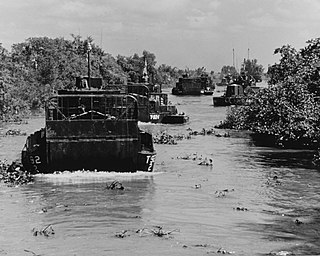
Operation Coronado IX was a riverine military operation conducted by the Mobile Riverine Force (MRF) of the United States and elements of the Army of the Republic of Vietnam (ARVN) from November 1967 to January 1968 in an attempt to destroy Viet Cong (VC) strongholds in the Mekong Delta. In the middle of November, clashes resulted in the capture of VC supplies and hideouts. During this period, the VC lost 178 men but killed only 26. For the next few weeks there was little contact, although some abandoned VC bunkers were destroyed and supplies captured. On 4 December, a large engagement occurred when a VC battalion encountered the South Vietnamese 5th Marine Battalion. 266 VC were killed, mostly by the Marines. The Marines lost 40 killed, while the Americans suffered 9 dead. Over the next month and the Christmas period, there was only sporadic skirmishes, but at the start of the new year, there were some medium size battles in which the Americans killed a few dozen VC. After this there was little contact.
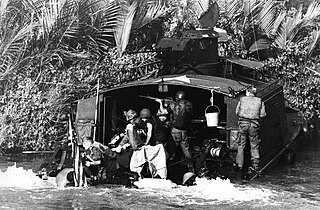
Operation Coronado XI was the eleventh of the Operation Coronado series of riverine military operations conducted by the U.S. Mobile Riverine Force (MRF) and units of the Army of the Republic of Vietnam (ARVN), designed to secure Cần Thơ in the aftermath of the Tet Offensive. It ran from 12 February to 3 March 1968.

Operation Silver City was an operation conducted by the 1st Brigade, 1st Infantry Division and the 173rd Airborne Brigade in Biên Hòa Province, lasting from 7 to 23 March 1966.

Operation Yellowstone was an operation conducted by the 1st and 3rd Brigades, 25th Infantry Division in northeast Tây Ninh Province, lasting from 8 December 1967 to 24 February 1968.

Operation Hardihood was a security operation conducted from 16 May to 8 June 1966 during the Vietnam War by the U.S. 503rd Infantry Regiment, the 1st Battalion, Royal Australian Regiment (1RAR) and the 5th Battalion, Royal Australian Regiment in Phước Tuy Province, South Vietnam to secure the area around Nui Dat for the establishment of a base area for the 1st Australian Task Force.
Operation Washington Green was a security and pacification operation during the Vietnam War conducted by the 173rd Airborne Brigade in Bình Định Province from 15 April 1969 to 1 January 1971.


















